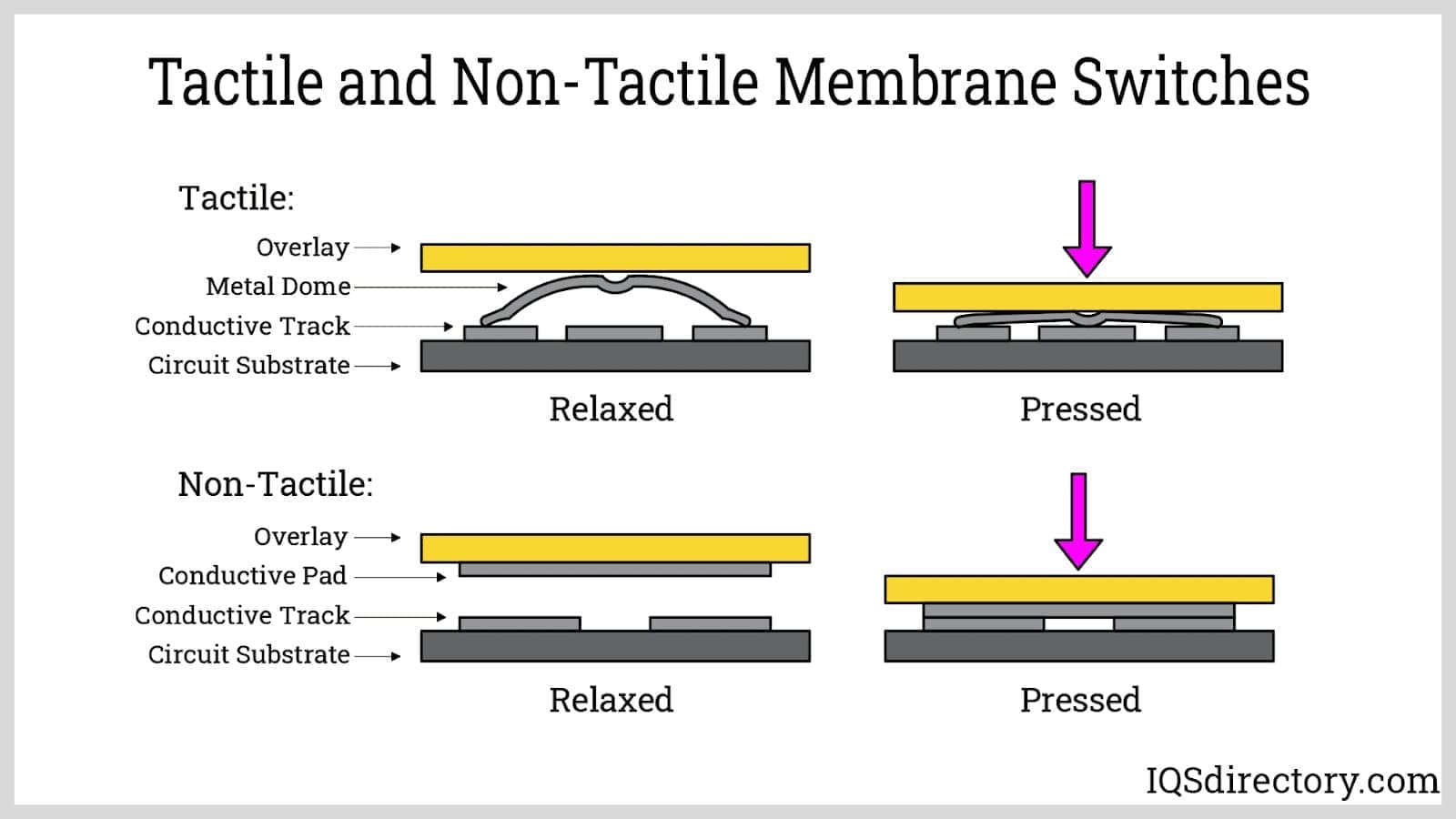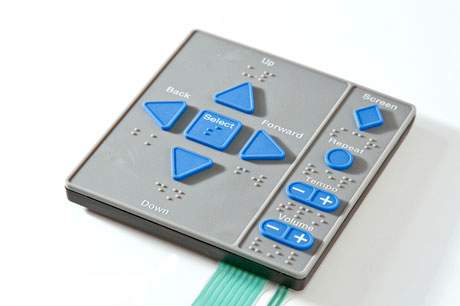Your Preferred Membrane Switch Manufacturer for Factory Applications
Your Preferred Membrane Switch Manufacturer for Factory Applications
Blog Article
How Membrane Switch Innovation Functions and Its Role in Customer Interface Design
Membrane button modern technology is an innovative technique that incorporates split materials for touch-sensitive input. When pressed, its layout is composed of graphic overlays, conductive layers, and adhesive elements that interact. This communication not just finishes an electrical circuit but also affects the general individual experience. Recognizing the details of this technology exposes its significant influence on individual interface layout, provoking inquiries concerning its applications and future advancements in numerous markets.
Understanding Membrane Switch Technology
Membrane button innovation acts as a critical part in modern individual interface style. This modern technology incorporates graphic overlays, touch-sensitive membrane layers, and circuit layers to develop a portable, reputable input method for numerous devices. The layout generally consists of multiple layers, including a printed visuals layer that allows customers to connect with the device through tactile comments. Membrane switches are recognized for their durability, resistance to dampness, and simplicity of cleaning, making them appropriate for environments where traditional mechanical buttons might fall short. Their low-profile design makes it possible for seamless combination right into gadgets, adding to a streamlined appearance. In addition, Membrane switches can be tailored with different colors, textures, and signs, enhancing individual experience and aesthetic charm. This versatility makes them preferred in customer electronics, medical tools, and commercial controls, where intuitive interaction is essential. Generally, Membrane switch modern technology represents a considerable advancement in how users engage with electronic user interfaces.
Secret Elements of Membrane Switches Over
Membrane switches contain several vital parts that contribute to their performance and design. The conductive layer products, glue and support layers, and visuals overlay design each play a crucial function in making sure ideal efficiency and individual interaction. Understanding these elements is essential for effective interface design.
Conductive Layer Materials
Conductive layer materials play a vital duty in the performance and dependability of Membrane switches. When pressure is used to the switch, these materials are liable for completing electrical circuits. Generally, a combination of conductive inks, such as silver or carbon, is utilized to create these layers. Silver conductive ink is favored for its remarkable conductivity and toughness, while carbon ink is commonly utilized for cost-efficient applications. The selection of product influences not only the electric performance yet likewise the overall life expectancy of the switch. In addition, the thickness and composition of conductive layers can influence responsive comments and switch actuation. Picking the ideal conductive material is vital for guaranteeing ideal efficiency in varied user interface applications.
Glue and Support Layers
Glue and support layers are crucial parts that add to the structural stability and capability of Membrane switches. These layers provide a robust foundation, making certain that the different elements of the Membrane switch stay securely bonded and properly aligned throughout their functional life. The glue layer assists in the accessory of the button to the underlying surface area, providing sturdiness versus ecological elements such as dampness, temperature variations, and mechanical tension. At the same time, support layers improve the button's rigidness, protecting against contortion during usage and contributing to a constant responsive feedback. With each other, these parts play a crucial duty in maintaining the performance and longevity of Membrane buttons, inevitably influencing the overall user experience in user interface style.
Graphic Overlay Style
Often forgotten, visuals overlay design plays a necessary role in the performance and appearances of Membrane switches. This design largely functions as the user interface between the user and the electronics, giving both aesthetic charm and operational clearness. Efficient graphic overlays use color, typography, and symbols to direct customers in comprehending and navigating controls gadget functions. Moreover, the selection of materials influences longevity and tactile feedback, making sure the overlay endures wear while preserving an enjoyable user experience. Furthermore, accurate placement of the overlay with the underlying components is crucial for perfect efficiency. To conclude, thoughtful graphic overlay style boosts usability, adds to brand name identification, and ultimately influences individual satisfaction in devices using Membrane button technology.
The Manufacturing Process of Membrane Switches
The manufacturing process of Membrane changes entails numerous crucial steps that ensure capability and durability. Initially, a graphic overlay is created, including interface components and branding. This overlay is printed onto a versatile substrate, normally polyester or polycarbonate, making use of accuracy printing strategies to identify quality and shade accuracy.Next, glue layers are used, complied with by the combination of conductive traces, commonly made from silver or carbon, which are crucial for electric connection. These traces are etched or screen-printed onto a different layer. After this, a spacer layer is included to develop the essential void in between the circuit and the overlay layer, permitting tactile feedback when activated.Finally, the parts are constructed and examined for top quality guarantee, assuring that each Membrane button satisfies the required specs for efficiency and reliability. This precise procedure results in a durable item fit for numerous applications in customer interface layout.
Benefits of Utilizing Membrane Switches

Membrane switches offer many benefits that make them a preferred selection in individual interface style. One significant advantage is their compact and light-weight nature, permitting structured designs in numerous applications. Additionally, Membrane switches supply a secured interface, protecting against dirt, moisture, and impurities, which enhances longevity and reliability. They their website are additionally highly adjustable, making it possible for designers to develop unique graphics and designs customized to certain user needs.Another advantage is their cost-effectiveness, as learn the facts here now they commonly require much less product and labor compared to conventional buttons. The responsive feedback of Membrane switches can be crafted to boost user experience, using an enjoyable response without the bulk of mechanical elements. Membrane switches can be quickly integrated right into diverse atmospheres, such as clinical tools, commercial tools, and customer electronics. Overall, these advantages highlight the growing popularity of Membrane switches in contemporary interface design.
Applications in Different Industries
Commonly used throughout various sectors, Membrane button modern technology has actually located its area in applications varying from clinical gadgets to consumer electronics. In the health care industry, these switches are important to gadgets such as diagnostic devices and client tracking systems, using long lasting, easy-to-clean user interfaces that stand up to sanitation procedures. The vehicle market employs Membrane buttons in dashboards and control panels, providing reputable operation in difficult environments.Consumer electronic devices, consisting of home devices and video gaming consoles, take advantage of the streamlined layout and customizability of Membrane switches, boosting individual interaction. Additionally, commercial machinery uses these buttons for control panels, making certain resistance to Resources dirt and dampness while preserving functionality.Moreover, the aerospace and armed forces sectors use Membrane buttons for rugged applications, where reliability and efficiency are essential. In general, Membrane switch innovation serves diverse markets by incorporating functionality, longevity, and visual charm, making it a flexible option for modern-day customer interfaces.

Designing Interface With Membrane Changes
When developing interface with Membrane buttons, careful consideration of both capability and aesthetic appeal is important. Membrane switches supply a sleek, low-profile layout that can improve visual charm while preserving usability. Designers must concentrate on switch design, guaranteeing intuitive placement for ease of operation. The responsive responses provided by the Membrane button is essential; it can impact customer contentment and total experience.Additionally, shade and graphic components ought to align with the brand name identification, reinforcing recognition and knowledge. Selecting resilient materials that withstand damage is likewise essential, as durability adds to use gradually. Incorporating backlighting can improve exposure in different lighting conditions, further boosting user interaction. Eventually, a properly designed Membrane switch interface equilibriums both type and function, guaranteeing that the individual experience is both engaging and effective, meeting the needs of varied applications across sectors.
Future Fads in Membrane Switch Innovation
As Membrane switch technology evolves, the integration of wise functionalities is ending up being significantly noticeable. These improvements enable improved interactivity and connection within user interfaces (membrane switch manufacturer). Furthermore, the change towards environment-friendly materials reflects a growing dedication to sustainability in layout practices
Smart Membrane Changes

Eco-Friendly Products Use
Amidst the advancements in Membrane switch technology, a substantial pattern is emerging in the direction of making use of green products. Manufacturers are significantly focusing on sustainability by integrating biodegradable plastics and non-toxic inks, lowering ecological impact. This shift not only lines up with international ecological standards but likewise addresses consumer need for greener items. Advancements in product science have allowed the advancement of long lasting, eco-friendly choices that preserve efficiency without endangering top quality. These products offer comparable functionality to traditional options while minimizing waste and toxicity. As sectors come to be a lot more eco-conscious, the combination of sustainable methods in Membrane switch manufacturing is anticipated to climb, enhancing a dedication to environmental responsibility and leading the way for even more lasting individual interface options in the future.
Frequently Asked Inquiries
Exactly How Do Membrane Switches Over Differ From Standard Mechanical Switches?
Membrane changes differ from typical mechanical switches primarily in building and operation. They make use of versatile layers that create a secured interface, whereas mechanical buttons depend on physical activity and get in touch with, resulting in distinctive toughness and tactile responses attributes.
Can Membrane Switches Be Custom-made for Certain Applications?
Membrane switches can certainly be customized for particular applications - membrane switch manufacturer. Manufacturers create them to fulfill special needs, permitting tailored formats, graphics, and functionalities that enhance customer communication and fit particular operational demands efficiently
What Is the Life-span of a Membrane Switch?
The life expectancy of a membrane layer switch commonly ranges from 1 to 5 million actuations, depending upon factors such as material top quality, ecological problems, and usage frequency. Routine screening can aid determine its durability and integrity in applications.
Are Membrane Switches Over Waterproof or Resistant to Chemicals?
Membrane switches can be developed to be waterproof and immune to chemicals, depending upon the materials utilized and producing procedures. Correct sealing and protective finishings boost their durability in various environmental conditions and applications.
How Do Membrane Changes Influence Device Energy Usage?
Membrane switches can substantially influence device energy consumption by guaranteeing effective operation. Their low power requirements during activation help minimize energy use, adding to longer battery life and total better performance in digital gadgets. Membrane switches are known for their resilience, resistance to moisture, and ease of cleansing, making them ideal for environments where traditional mechanical switches may fail. The automotive market uses Membrane buttons in dashboards and control panels, supplying reputable operation in tough environments.Consumer electronics, including home devices and video gaming consoles, benefit from the smooth style and customizability of Membrane buttons, boosting customer interaction. Furthermore, industrial equipment uses these switches for control panels, ensuring resistance to dust and moisture while preserving functionality.Moreover, the aerospace and military markets use Membrane switches for tough applications, where reliability and efficiency are vital. The advancement of Membrane switch technology is getting in an amazing stage with the development of wise Membrane switches, which incorporate advanced functions and functionalities. Membrane switches over vary from traditional mechanical switches mainly in building and construction and operation.
Report this page